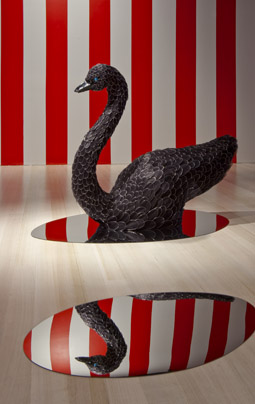unexpected art
lucy hawthorne: ten days on the island: icelandic love corporation

Installation detail, Hospitality, Icelandic Love Corporation
photo courtesy Ten Days on the Island
Installation detail, Hospitality, Icelandic Love Corporation
WALKING INTO ICELANDIC LOVE CORPORATION’S HOSPITALITY IS LIKE ENTERING A SURREAL CIRCUS TENT. MIRRORS REFLECT RED AND WHITE STRIPED WALLS, AN OVERSIZED JEWEL-EYED SWAN RESTS BENEATH A DISCO BALL, WHILE A PROJECTED VIDEO PROVIDES A HARMONICA SOUNDTRACK. THE OPENING NIGHT PERFORMANCE ADDS TO THE SENSORY OVERLOAD, WHEN THE ARTISTS’ SPECIALTY COOKING FILLS THE SPACE WITH THE AROMA OF SPICY FRIED PASTRIES. IT’S AN UNLIKELY AND OVERWHELMING ENVIRONMENT, AND YET THE PARTICIPATORY PERFORMANCE TURNS THE OTHERWISE ANXIETY INDUCING SPACE INTO A WELCOMING AND FUN EXPERIENCE.
The Icelandic Love Corporation (ILC) is a collaborative trio of female artists Sigrún Hrólfsdóttir, Jóni Jonsdóttir and Eirún Sigurdardóttir who work across a range of mediums but are most renowned for their performances. Their art is celebratory and humorous, exploring themes of love and the unexpected.
Elements of play are evident everywhere in this bizarre exhibition. Amidst the uneven lighting, the giant black swan and a velvet tent are dramatically spotlit. Hand crocheted eggs nestled within the dark tent require some co-ordinated bending to view. Those of us wearing skirts at the opening avoid the perilous egg-shaped mirrors on the floor. The disco ball is a quirky addition although, disappointingly, it doesn’t throw any light against the walls.
The objects, clustered in the centre of the gallery, take up little floor space but the carnivalesque red and white stripes fill the walls, breaking down the seriousness, and emptiness, of the gallery’s white cube, creating an illusion of intimacy.
The video, A Black Swan, projected onto the only unpainted section of the wall in an uncomfortable location, opens and closes with animated red and white striped curtains that rhyme with the surrounding walls. It’s a somewhat tragic but simultaneously humorous tale, which conveys the ILC’s mantra: “Love conquers all! The future is beautiful.” The story is closely related to the exhibition’s title, Hospitality, exploring as it does the topical issues of unwanted foreign guests and fear of the unknown.
The native Australian black swan is believed to pose a threat to the native European white swan, and the killing of black swans is actually encouraged in Denmark to prevent interbreeding, which would apparently result in grey swans. In the video, we follow the journey of a crudely animated pair of black swans departing Australia. One is shot as they pass over Europe and, after briefly meeting a white swan, the lonely bird is plunged into a fiery landscape of crocheted flames. Eventually, the reluctant bird exits through a barrier where it meets a white swan, falls in love, and after caressing and contentedly curling up together, they eventually morph into grey scale birds—the dreaded half-breeds. The quirky symbolism, jerky animation and simple harmonica soundtrack are quaint, and the inclusion of the crocheted flames and other craft references connect the animation with the rest of the exhibition beyond the swan subject matter.
Googled, The Black Swan Theory refers to an unpredictable, unexpected but high-impact event or occurrence. In Europe, it was long assumed that all swans were white, and the term ‘black swan’ was used as a metaphor for something that did not exist. However, when Europeans discovered the native Australian black swan in the 18th century, this long-held belief was destroyed. The term can be widely applied,for example to the literary phenomenon of Harry Potter, 9/11, the current financial crisis or the introduction of rabbits and cane toads into Australia—all entities and incidents that seem foreseeable in hindsight. Hospitality doesn’t appear to explore the theory per se, despite the suggestion of the text accompanying the exhibition. However, the video does relate to the origins of the theory, and the exhibition certainly tries to create an unexpected gallery environment by combining a selection of improbable images and objects.
The performance appears quite disconnected from the exhibition. It involves an inverse interpretation of the notion of hospitality. Our Icelandic ‘guests’ set up a temporary kitchen at one end of the striped gallery, cooking for their ‘hosts’ traditional Icelandic deep-fried pastries, or Kleiners, which are to be accompanied by a glass of cold milk. Unlike regular openings, where the exhibiting artists mingle with the viewers, there is little personal communication between the ILC and us. The trio stand behind a table, churning out the cardamon spiced treats, handing out copies of the recipe, complete with crude illustrations, for us to try at home, and stopping people as they try to walk away with wine rather than milk. As someone who is unable to drink milk, I’m one of the many who is pulled up; and while I’m embarrassed at the time, on reflection I realise that this is not the first time I’ve felt the uncomfortable predicament of whether or not to refuse food that people have hospitably cooked for me at the risk of my feeling sick. This familiar, and yet incredibly personal, dilemma, whether or not to offend, made the performance for me. While I understand that there are probably good reasons why there was no documentation of the performance shown during the four-week exhibition, it’s a shame that most viewers were oblivious to what I felt was the strongest part of Hospitality.
Apart from the performance, I found myself engaging with the exhibition rather intellectually, marvelling at the kitsch, the effect of the striped walls, the shine of the swan’s beak. I don’t necessarily see this as a bad thing. Hospitality is a fun experience, living up to the ILC claim that they “like to have a dialogue and discussion with [their] audience and humour is a good way of doing that.”
The Icelandic Love Corporation, Hospitality, CAST gallery, Ten Days on the Island, Hobart, March 26-April 24
RealTime issue #91 June-July 2009 pg. 17






